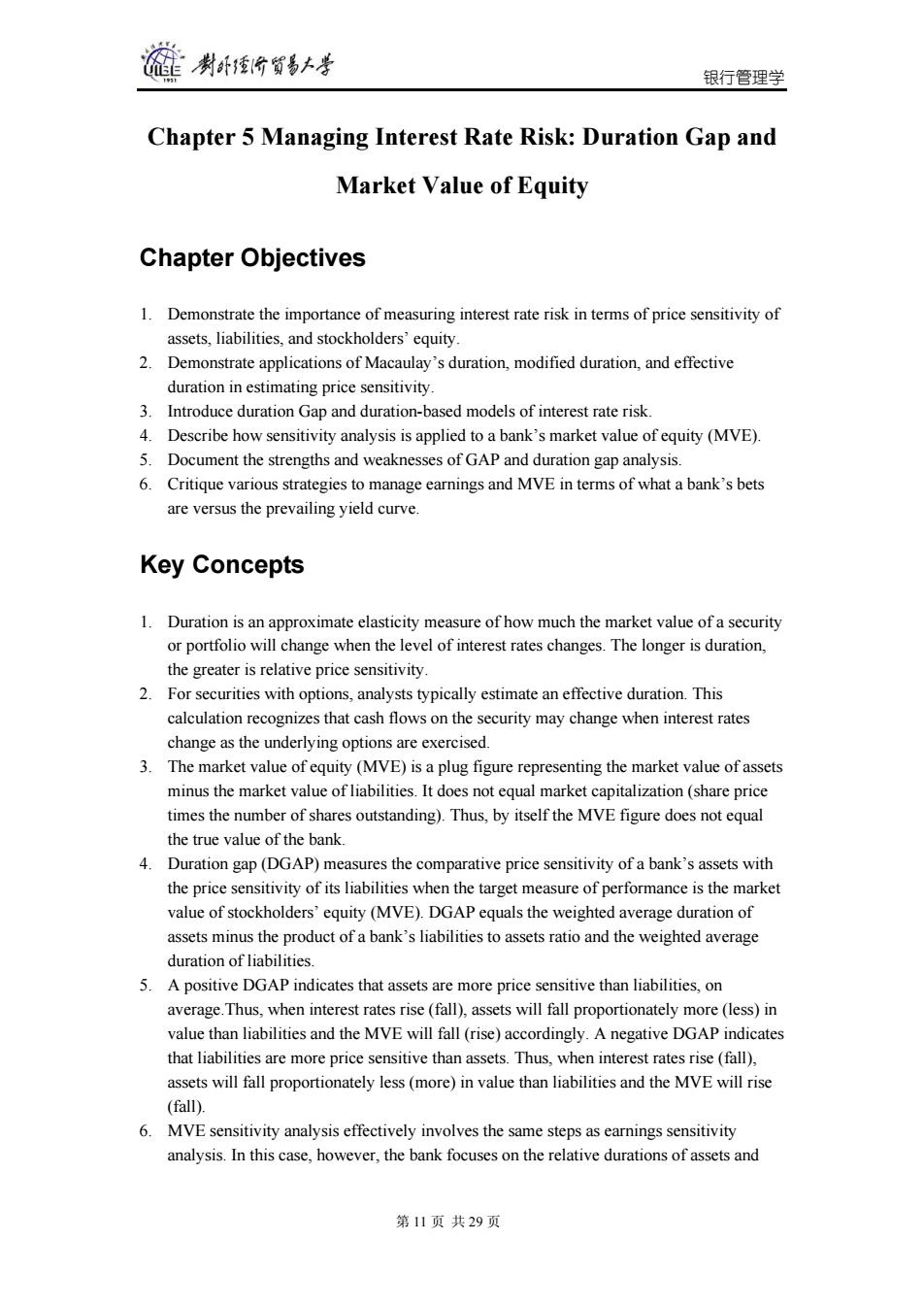正在加载图片...

碰制价贺多上考 银行管理学 Chapter 5 Managing Interest Rate Risk:Duration Gap and Market Value of Equity Chapter Objectives 1.Demonstrate the importance of measuring interest rate risk in terms of price sensitivity of assets,liabilities,and stockholders'equity. 2.Demonstrate applications of Macaulay's duration,modified duration,and effective duration in estimating price sensitivity. 3.Introduce duration Gap and duration-based models of interest rate risk. 4.Describe how sensitivity analysis is applied to a bank's market value of equity (MVE). 5.Document the strengths and weaknesses of GAP and duration gap analysis. 6.Critique various strategies to manage earnings and MVE in terms of what a bank's bets are versus the prevailing yield curve. Key Concepts 1.Duration is an approximate elasticity measure of how much the market value of a security or portfolio will change when the level of interest rates changes.The longer is duration, the greater is relative price sensitivity. 2.For securities with options,analysts typically estimate an effective duration.This calculation recognizes that cash flows on the security may change when interest rates change as the underlying options are exercised. 3.The market value of equity (MVE)is a plug figure representing the market value of assets minus the market value of liabilities.It does not equal market capitalization(share price times the number of shares outstanding).Thus,by itself the MVE figure does not equal the true value of the bank. 4.Duration gap(DGAP)measures the comparative price sensitivity of a bank's assets with the price sensitivity of its liabilities when the target measure of performance is the market value of stockholders'equity (MVE).DGAP equals the weighted average duration of assets minus the product of a bank's liabilities to assets ratio and the weighted average duration of liabilities. 5.A positive DGAP indicates that assets are more price sensitive than liabilities,on average.Thus,when interest rates rise(fall),assets will fall proportionately more(less)in value than liabilities and the MVE will fall(rise)accordingly.A negative DGAP indicates that liabilities are more price sensitive than assets.Thus,when interest rates rise(fall), assets will fall proportionately less(more)in value than liabilities and the MVE will rise (fall). 6.MVE sensitivity analysis effectively involves the same steps as earnings sensitivity analysis.In this case,however,the bank focuses on the relative durations of assets and 第11页共29页银行管理学 第 11 页 共 29 页 Chapter 5 Managing Interest Rate Risk: Duration Gap and Market Value of Equity Chapter Objectives 1. Demonstrate the importance of measuring interest rate risk in terms of price sensitivity of assets, liabilities, and stockholders’ equity. 2. Demonstrate applications of Macaulay’s duration, modified duration, and effective duration in estimating price sensitivity. 3. Introduce duration Gap and duration-based models of interest rate risk. 4. Describe how sensitivity analysis is applied to a bank’s market value of equity (MVE). 5. Document the strengths and weaknesses of GAP and duration gap analysis. 6. Critique various strategies to manage earnings and MVE in terms of what a bank’s bets are versus the prevailing yield curve. Key Concepts 1. Duration is an approximate elasticity measure of how much the market value of a security or portfolio will change when the level of interest rates changes. The longer is duration, the greater is relative price sensitivity. 2. For securities with options, analysts typically estimate an effective duration. This calculation recognizes that cash flows on the security may change when interest rates change as the underlying options are exercised. 3. The market value of equity (MVE) is a plug figure representing the market value of assets minus the market value of liabilities. It does not equal market capitalization (share price times the number of shares outstanding). Thus, by itself the MVE figure does not equal the true value of the bank. 4. Duration gap (DGAP) measures the comparative price sensitivity of a bank’s assets with the price sensitivity of its liabilities when the target measure of performance is the market value of stockholders’ equity (MVE). DGAP equals the weighted average duration of assets minus the product of a bank’s liabilities to assets ratio and the weighted average duration of liabilities. 5. A positive DGAP indicates that assets are more price sensitive than liabilities, on average.Thus, when interest rates rise (fall), assets will fall proportionately more (less) in value than liabilities and the MVE will fall (rise) accordingly. A negative DGAP indicates that liabilities are more price sensitive than assets. Thus, when interest rates rise (fall), assets will fall proportionately less (more) in value than liabilities and the MVE will rise (fall). 6. MVE sensitivity analysis effectively involves the same steps as earnings sensitivity analysis. In this case, however, the bank focuses on the relative durations of assets and